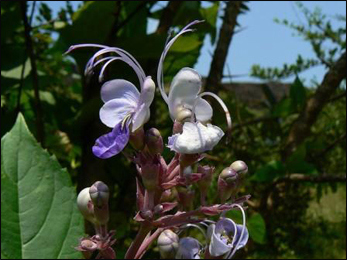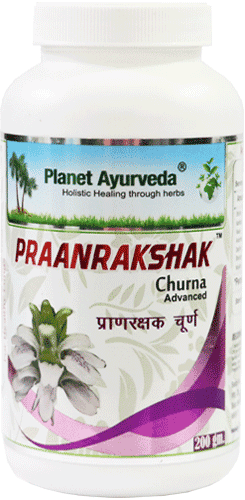Bharangi (Clerodendrum Serratum) – Uses, Benefits, Properties, Dosage and Side Effects

Bharangi is oldest herb used in ayurvedic system which is very famous for healthy respiratory system and to give good rhythm to voice. Its common names are glory bower, bag flower and bleeding heart. Bharangi Plant Leaves are used to increase appetite and also has expectoration activities. Bharangi flowers resemble to lotus. Bharangi was discovered by rishi “Bhrigu” thousands of years back.
Description of Bharangi Plant
Bharangi Plant is perennial woody shrub with bluntly quadrangular stems. Bharangi Leaves are usually three at node, 3-8 inch long, oval in shape with sharp thorns. Bharangi Thorns are pulpy and oily. Bharangi Flowers grow in bunches are slightly fragrant and pale blue pinkish in color. Bharangi Fruits appear in group of 16 and after ripening color changes to purple black. Bharangi Flowers appear in summer season and fruits at the end of rainy season.
General Information
Bharangi Botanical name is Clerodendrum Serratum and it is woody medicinal shrub used in ayurvedic system for his various medicinal properties. It is also called “Kasaghni” and is best used to cure respiratory system related diseases. Decoction prepared by leaves has bronchodilator effect. It is not toxic plant, flowers and leaves are also edible. Root of this plant is bitter, dry, anti-inflammatory, digestive, carminative, stimulant, expectorant and anti-spasmodic in nature. This herb contains hispidulin, 7-0 glucurodines, scutellarein, uncinatone etc. Its roots contain various chemical compounds like saponnins, D- mannitol, oleanic acid, steroidal glycosides, ferulic acid, arabinose and urosolic acid. Leaves are rich in luteoline, polyphonolics, carbohydrates, phenolics, terpenes and steroids.
Habitat
Bharangi is a medicinal shrub growing in tropical and warm regions of world. There are about 150 to 450 species of this plant and it is distributed throughout world. Especially, it is found in warm temperate regions and native of South Africa, Southern Asia and Malaysia and distributed in various regions of tropical America, Northern Australia, India and Sri Lanka. In India Bharangi plant is easily available in regions like Himalayan region, Bhopal, Bengal and Bihar. Red loam soils are best for the growth of this herb.
Bharangi Scientific Classification
- Kingdom – Plantae
- Order – Lamiales
- Family – Lamiaceae
- Subfamily – Teucrioideae
Bharangi Name
- Latin name – Clerodendrum serratum
- English name – Turk’s turban moon, Beetle killer, Blue glory
- Sanskrit name – Bhramanayastika, Kharashakha, Padma, Kasajith, Barbura
- Common names – Bharangi, Kasaghni, Phajuka, Vtari, Beetle killer, Blue glory
- Hindi name – Bharangi, Babhanaiti
- Malayalam – Kankabharani
- Bengali name – Bamun hatee, Baman hatee, Bhumijam
- Gujarat name – Bharangee
- Kannada name – Gantubarangee
- Oriya name – Chinds
- Punjabi name – Bhadangee
- Tamil name – Cheruteku
- Telgu name – Canttubrarangee
- Urdu name – Bharangi, Baharangi
Ayurvedic Properties of Bharangi
| Hindi / Sanskrit | English | ||
| Rasa | Katu, Tikta | Taste | Pungent, Bitter |
| Guna | Laghu, Ruksha | Physical Property | Light, Dry |
| Virya | Ushna | Potency | Hot |
| Vipaka | Katu | Metabolic Property (After Digestion) |
Pungent |
Bharangi Effects on Doshas
It balances kapha and vata doshas.
| Charak Samhita | Sushrut Samhita | Ashtanga sanghrah | Ashtang hridya |
| Pureesh sanghrehniya – Herbs used to increase the bulk of feces. | Pipalyadi gana. | Pipalyadi gana | Akradi and Sursadi gana |
Ancient verse about Bharangi


- According to first shalok Bharagi, bhrigubhava, padma, fajji, barahmanyashtica, brahmani, angaarvalli, kharshak and hajjika are the various synonyms of bharangi. It has various properties like bitter and astringent taste, rookash (dry) and laghu (light) guna, hot potency and it helps to stimulate digestive fire. The herb is used to cure abdominal tumors (gulam), bleeding disorders (rakta pitta), swelling (shoth), cough (kaas), asthma (shwaas), rhinitis (peenas), fever (jwara) and pacifies vata dosha.
- According to second shalok Sati (Hedychium spicatum), Pushkaramoola (Inula racemosa), Bharangi (Clerodendron serratum), Patha (Cissampelos pareira), Katphala (Myrica nagi), Devdaru (Cedrus deodara), Karkatshringi (Pistacia integerrima) decoction of all the medicinal herbs are used to cure fever due to vitiation of kapha (kaphaj jwara).
Practical Uses of Bharangi
- Kasaghni is common name of this herb and is used to cure common cold, cough, tuberculosis, rhinitis, Asthma (shwasa roga), chronic respiratory disorders and their underlying symptoms.
- Decoction of leaves acts as bronchodilator and mucolytic in nature and it is used to break down phlegm, extra mucus and eases it out from body.
- Paste of bharangi leaves are used in lymphadenopathy.
- Root of this herb is used to treat jaundice and various disorders associated with liver.
- It is helpful in the pacification of vata dosha and is useful in rheumatic conditions, gout and joint pain.
- Bharangi has anti-microbial properties and used in various worm infestations.
- It acts as appetizer and used to stimulate digestive fire.
- Root paste of Bharangi applied on forehead relieves headaches.
- Decoction of this herb is used to cure cyst, raktagulam and uterine fibroids.
- Paste of leaves are applied on wounds and ulcers to extract out extra pus and relieve burning sensation. It is also helpful in the quick healing of abscesses.
- It is also used to cure abdominal tumors.
- This herb has anti-inflammatory properties and reduce inflammation.
- It pacifies vata and kapha roga.
Dosage
Powder : 3-6 gm
Part Used
- Bharagi Roots
- Bharagi Leaves
Bharagi Side Effects
There are no side effects of this herb.
Ayurvedic Products from Bharangi by Planet Ayurveda
1. Praanrakshak Churna
Praanrakshak Churna is a useful combination of anti-allergic herbs used in Ayurveda since 5000 B.C. for asthma and allergy. These herbs act together in a synergistic manner and are effective in chronic allergies, respiratory tract infections, chronic bronchitis and asthma. The herbs Bharangi, Kantkari and Shirish act as powerful antihistaminic and are effective in treating acute and chronic Asthmatic attacks. Vasa and Madhuyashti herbs break the mucous plugs and are useful even in common cough, bleeding while coughing and also heals the inflamed respiratory tract. Tylophora asthmatica as the name indicates is another useful herb in curing asthma.





1 thought on “Bharangi / Clerodendrum Serratum”